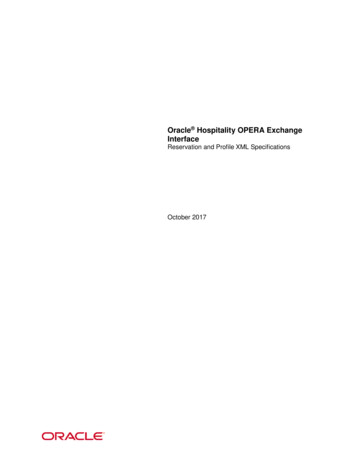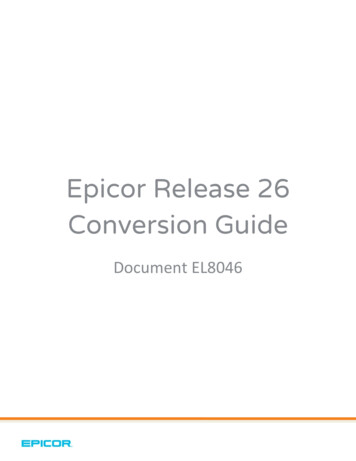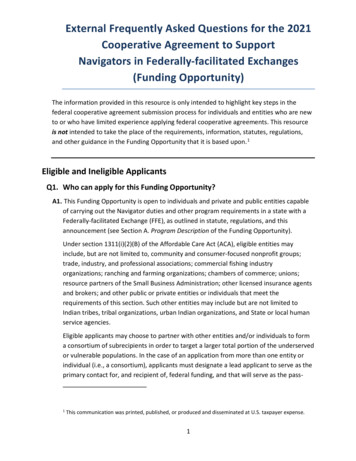
Transcription
External Frequently Asked Questions for the 2021Cooperative Agreement to SupportNavigators in Federally-facilitated Exchanges(Funding Opportunity)The information provided in this resource is only intended to highlight key steps in thefederal cooperative agreement submission process for individuals and entities who are newto or who have limited experience applying federal cooperative agreements. This resourceis not intended to take the place of the requirements, information, statutes, regulations,and other guidance in the Funding Opportunity that it is based upon. 1Eligible and Ineligible ApplicantsQ1. Who can apply for this Funding Opportunity?A1. This Funding Opportunity is open to individuals and private and public entities capableof carrying out the Navigator duties and other program requirements in a state with aFederally-facilitated Exchange (FFE), as outlined in statute, regulations, and thisannouncement (see Section A. Program Description of the Funding Opportunity).Under section 1311(i)(2)(B) of the Affordable Care Act (ACA), eligible entities mayinclude, but are not limited to, community and consumer-focused nonprofit groups;trade, industry, and professional associations; commercial fishing industryorganizations; ranching and farming organizations; chambers of commerce; unions;resource partners of the Small Business Administration; other licensed insurance agentsand brokers; and other public or private entities or individuals that meet therequirements of this section. Such other entities may include but are not limited toIndian tribes, tribal organizations, urban Indian organizations, and State or local humanservice agencies.Eligible applicants may choose to partner with other entities and/or individuals to forma consortium of subrecipients in order to target a larger total portion of the underservedor vulnerable populations. In the case of an application from more than one entity orindividual (i.e., a consortium), applicants must designate a lead applicant to serve as theprimary contact for, and recipient of, federal funding, and that will serve as the pass-1This communication was printed, published, or produced and disseminated at U.S. taxpayer expense.1
External Frequently Asked Questions for the 2021Cooperative Agreement to SupportNavigators in Federally-facilitated Exchanges(Funding Opportunity)through entity for making federal funds awarded under the Funding Opportunityavailable to other consortium members.Q2. What happens if an organization is awarded Navigator funding to serve astate that transitions from an FFE to a State-based Exchange (SBE) orState-based Exchange on the Federal Platform (SBE-FP) during the 36month project period of performance?A2. Should the FFE in a state (or, in the case of a multi-state award, all applicable states) inwhich a Navigator awardee has received funding through this Funding Opportunitytransition from an FFE to an SBE or SSBE-FP before the 36-month project period ofperformance ends, the Navigator cooperative agreement would end and any unusedfunds would be returned to HHS. In accordance with 45 C.F.R. §155.106, any stateseeking approval from HHS to operate an SBE or SBE-FP must coordinate with HHS on ajointly-developed transition plan, including a process and timeline for ending thiscooperative agreement. In the case of a multi-state award, the Navigator cooperativeagreement would remain in place for any FFE in a state that remains an FFE.Q3. Are there any prohibitions for Agents and Brokers who want to apply forNavigator funds under this Funding Opportunity?A3. Yes. Although licensed agents and brokers are eligible to apply, section 1311(i)(4) of theACA prohibits a Navigator from being “a health insurance issuer” or from “receiv[ing]any consideration directly or indirectly from any health insurance issuer in connectionwith the enrollment of any qualified individuals or employees of a qualified employer ina qualified health plan.” CMS regulations at 45 C.F.R. §§ 155.210(d)(1)-(4) and155.215(a)(1) implement this statutory provision.In guidance, CMS has explained that agents and brokers who sell lines of insuranceother than health insurance or stop loss insurance (for example, auto, life, andhomeowners’ policies) would not be prohibited from receiving consideration from thesale of those other lines of insurance while serving as a Navigator. However, agents andbrokers that sell lines of insurance other than health insurance or stop loss insurance,and that opt to become Navigators, would have to disclose these non-prohibited lines of2
External Frequently Asked Questions for the 2021Cooperative Agreement to SupportNavigators in Federally-facilitated Exchanges(Funding Opportunity)business to the FFE and (in plain language) to each consumer assisted, per §155.215(a)(1)(iv)(A).Q4. Are tribal entities eligible to apply under this announcement?A4. Yes, Indian Tribes, tribal organizations, and urban Indian organizations are eligible toapply. Tribal Applicants should include the federally recognized Indian Tribal lands oftheir target Tribal population, the county(ies) it includes, and how they plan to serve thedifferent geographic areas of their target population in their application, as noted in theFunding Opportunity.Q5. Are individuals eligible to apply to be a Navigator?A5. Yes. However, all applicants, including those applying as individuals, must apply using avalid Employer Identification Number (EIN), or other Taxpayer Identification Number(TIN) assigned by the Internal Revenue Service. Individuals may choose to provide theirpersonal Social Security Numbers (SSNs) to apply via Grants.gov. In compliance withSection 7 of the Privacy Act of 1974, please note that disclosure of your SSN is voluntary,the submission of your SSN is not mandated by any statutory authority, and this numbermay be used for all of the following purposes: To verify an individual applicant is a U.S. Citizen or a legal permanent resident. To confirm the individual does not owe any debt to the federal government. To confirm if the individual is debarred or suspended from participation inFederal assistance programs (see the Department of Health & Human Services(HHS) Grants Policy Statement). To complete a background check on the individual. To comply with HHS business review requirements, the SSN may be used todetermine the adequacy of the applicant’s financial and business managementcapabilities that will support the expenditure of and accountability for CMSfunds. This may include submitting the individual’s SSN for a credit check. If selected for award, to create an account in the Payment Management Systemlinked to the SSN.3
External Frequently Asked Questions for the 2021Cooperative Agreement to SupportNavigators in Federally-facilitated Exchanges(Funding Opportunity) If selected for award, to create an account in the Grants Management systemused to manage, monitor, and make changes to awards. This system is also usedfor regular correspondence between the awardee and CMS. If selected for award, the individual will have to insert the SSN on all federalreporting forms completed in the Payment Management System and/or GrantsManagement System used by CMS.Q6. Can a state-run or public hospital apply to be a Navigator? What if itreceives payment from an issuer for services rendered?A6. Yes, hospitals are generally considered eligible to apply for Navigator funding.Regarding the receipt of payment from a health insurance issuer or issuer of stop lossinsurance, pursuant to 45 C.F.R § 155.210(d)(4), in the FFEs, no health care provider(such as a hospital) would be ineligible to operate as a Navigator solely because itreceives consideration from a health insurance issuer for health care services provided.Q7. Is an entity that sells Medicaid or Medicare managed care plans eligible toapply to be a Navigator?A7. It depends. If an applying entity or one of its corporate affiliates is required to belicensed to engage in the business of insurance in a state and is subject to state law thatregulates insurance, it might be a health insurance issuer or have a relationship with ahealth insurance issuer that would make it ineligible to enter into a Navigatorcooperative agreement. See definition of “health insurance issuer” at 45 C.F.R. §§155.20 and 144.103. CMS will evaluate specific corporate structures on a case-by-casebasis. The Funding Opportunity requires applicants to submit a brief statement attestingthat they are not an ineligible entity. Please keep the foregoing guidance in mind whendrafting that statement (for example, by disclosing any corporate relationships with anentity that is required to be licensed to engage in the business of insurance in a stateand that is subject to state law that regulates insurance).4
External Frequently Asked Questions for the 2021Cooperative Agreement to SupportNavigators in Federally-facilitated Exchanges(Funding Opportunity)Q8. Is there anyone who is ineligible to apply for this Funding Opportunity?A8. Yes, health insurance issuers; subsidiaries of health insurance issuers; issuers of stoploss insurance and their subsidiaries; associations that include members of, or lobby onbehalf of, the insurance industry; or recipients of any direct or indirect considerationfrom any health insurance or stop loss insurance issuer in connection with theenrollment of any individuals or employees in a qualified health plan (QHP) or non-QHP.CMS has clarified in regulation that no health care provider shall be ineligible to operateas a Navigator in an FFE solely because it receives consideration from a health insuranceissuer for health care services provided.Q9. Are there any additional requirements after awards are made to ensurethat an awardee remains eligible throughout the course of the 36-monthperiod of performance?A9. Yes. Recipients must continue to meet all eligibility requirements and reportingdeadlines laid out in the Funding Opportunity (see Sections A4. ProgramRequirements, C1. Eligible Applicants, and F5. Reporting of the FundingOpportunity) to be eligible throughout the initial 12-month budget period, andto remain eligible for a non-competing continuation award for subsequentbudget periods of the 36-month period of performance. CMS will provideawardees the instructions for completing the Federal Navigator training andreporting requirements. Pursuant to CMS regulations at 45 C.F.R. § 155.215(b)(1)(iv), Navigatorcooperative agreement awardees in the FFEs must obtain continuing educationand be certified and/or recertified on at least an annual basis. CMS regulations at 45 C.F.R. § 155.210(c)(1)(iii) require that entities andindividuals eligible to receive a Navigator grant must meet any applicable Stateor Exchange licensing, certification, or other standards, if applicable, so long assuch standards do not prevent the application of the provisions of title I of theACA.5
External Frequently Asked Questions for the 2021Cooperative Agreement to SupportNavigators in Federally-facilitated Exchanges(Funding Opportunity) Consistent with 45 C.F.R. § 155.215(a)(1)(i), all applicants (individuals, entities,and all members making up a consortium) must submit a brief statement (one ortwo short paragraphs) within the Cover Letter attesting that they, as Navigatorcooperative agreement applicants, are not ineligible entities, and includeattestations that all other Navigator entities (including the Navigator(s),Navigator's staff, and subrecipients and contractors performing Navigatorduties), do not have any of the prohibited relationships with health insurance orstop loss insurance issuers. As is explained in 45 C.F.R. § 155.215 and thepreamble language discussing that provision, some conflicts of interest (otherthan the prohibited relationships outlined above) would not be absolute bars toservice as a Navigator, provided that the conflict of interest would not ultimatelyprevent the entity or individual from providing information and services in a fair,accurate, and impartial manner. In addition, in accordance with 45 C.F.R. §155.215(a)(1)(ii) and in compliance with the Standard Terms and Conditions thatwill be included in a Notice of Award, all successful applicants will be required toprovide a written plan to remain free of conflicts of interest during the term as aNavigator and to disclose to CMS, as operator of the FFE, and to each consumerwho receives application assistance from the Navigator certain non-disqualifyingconflicts of interest as specified in 45 C.F.R. § 155.215(a)(1)(iv). Please also see sections A4. Program Requirements and B2. Award Informationof the Funding Opportunity for additional information on what is considered tobe strong performance for continued funding throughout the duration of the 36month period of performance. At any time in the period of performance,recipients could receive decreased funding or their award could be terminated ifthey fail to perform the requirements of the award.Q10. Can a consortium with multiple entities and/or individuals divide therequired Navigator duties so that one group is performing some of theduties and another group is performing other duties?A10. Yes, as long as all of the required duties of a Navigator are successfully carried outaccording to the Funding Opportunity and terms and conditions of the cooperativeagreement, once awarded. Although a consortium may meet this requirement in6
External Frequently Asked Questions for the 2021Cooperative Agreement to SupportNavigators in Federally-facilitated Exchanges(Funding Opportunity)different ways, every lead agency of a consortium applying for Navigator funds mustoversee the cooperative agreement funds and all related activities of its own staff andeach subrecipient and/or contracted entity/individual(s) performing one or more of theNavigator duties. Further, we recognize that different members of a consortium mayhave expertise in different areas, such as outreach and education or facilitating selectionof a QHP.Therefore, it’s permissible for one consortium member to focus on outreach andeducation, while another one focuses on QHP enrollments/re-enrollments, for example.However, all paid and unpaid staff with the lead agency that received the Notice ofAward, including its subrecipients and/or contractors that comprise the consortium,who are conducting Navigator duties must have the ability to help any individual whopresents themselves for assistance. Additionally, we expect that all paid and unpaid staffassociated with a Navigator cooperative agreement that will be carrying out Navigatorduties would be trained, in accordance with Navigator training standards andrequirements, to perform all of the duties of a Navigator and would be equipped toassist consumers through outreach, education, and during the eligibility and enrollmentprocesses.ProposalsQ11. Can my group/organization apply to be a Navigator awardee in more thanone FFE?A11. Yes. An applicant may propose to serve populations in multiple FFEs through thesubmission of one application. However, the applicant must submit separate BudgetNarratives and project (metric) goals for each FFE it proposes to serve (see Section D.Application and Submission Information of the Funding Opportunity for additionalinformation). If an applicant is proposing to serve in more than one FFE, the applicantshould be prepared to revise its project scope and budget upon award if it is not fundedto serve in all proposed FFEs and/or at the full amount requested.Regardless of how many FFEs an applicant proposes to serve, only one SF-424A needs tobe submitted that must include the combined total funds requested for each line itemcategory as well as the overall total cooperative agreement requested funds of all FFEs.7
External Frequently Asked Questions for the 2021Cooperative Agreement to SupportNavigators in Federally-facilitated Exchanges(Funding Opportunity)When operating a multi-state cooperative agreement, the awardee will also be requiredto comply with all applicable state requirements in order to operate as a Navigator ineach FFE state.Q12. If awarded a Navigator grant, is an applicant required to serve the entireExchange service area, even though it proposes to serve some of thecounties or parishes (less than statewide), for example?A12. No. However, if awarded, Navigators must assist any consumer seeking assistance,even if that consumer is not a member of the community(ies) or group(s) the applicantexpects to target, as outlined in its funding proposal. There may be some instanceswhere a Navigator does not have the immediate capacity to help an individual. In suchcases, the Navigator should make every effort to provide assistance in a timely manner,but could also refer consumers seeking assistance to other resources, such as the tollfree Exchange call center or certified application counselors. CMS has also publishedguidance 2 on when Navigators may refer consumers to agents and brokers. Whenmaking these referrals, Navigators should refer consumers to general resources they canuse to search for an agent or broker near where they live, such as Find Local Help onHealthCare.gov. Additionally, if a Navigator in an FFE is approached by a consumer wholives in a state with a State-based Exchange (SBE), or in a state with an FFE in which theNavigator has not been funded to serve, the Navigator should refer the consumer to anExchange-approved assister in the consumer’s state or, if available, a toll-free SBEconsumer assistance number.See Tips for Assisters on Working with Outside Organizations, found tsideorganizations.pdf28
External Frequently Asked Questions for the 2021Cooperative Agreement to SupportNavigators in Federally-facilitated Exchanges(Funding Opportunity)Q13. Do Navigators have to maintain a physical presence in the FFE servicearea it is approved to serve?A13. No. The HHS Notice of Benefit and Payment Parameters for 2019 Final Rule, effective6/18/2018, eliminated the requirement for Navigators to maintain a physical presencein the Exchange service area it is approved to serve. However, applicants thatdemonstrate the ability to maintain these relationships and establish new relationshipsthrough a physical presence and other demonstrated ties to the local community(ies) intheir proposed service area(s) may receive a higher score in this category than thosewho do not.Q14. Is a Letter of Intent required?A14. No.Q15. How are underserved or vulnerable populations defined in this FundingOpportunity?A15. As explained in 45 C.F.R. § 155.210(e)(8) and the preamble language discussing thatprovision, the primary criteria to be used in identifying underserved or vulnerablepopulations in the FFEs is whether the community is disproportionately without accessto coverage or care, or is at a greater risk for poor health outcomes as a result ofdisparities in health insurance coverage, access to quality care, and other social,environmental, and economic factors shown to impact health.For purposes of this Funding Opportunity, the Exchange will consider a population to beunderserved or vulnerable using factors such as race or ethnicity, gender, education orincome, disability, geographic location (e.g., rural or urban), or sexual orientation.Examples of underserved or vulnerable populations may include, but are not limited to: Racial and ethnic minoritiesRural communitiesLesbian, gay, bi-sexual, transgender, queer, and other (LGBTQ )individualsLow income or homeless individualsAmerican Indians and Alaska Natives (AI/AN)9
External Frequently Asked Questions for the 2021Cooperative Agreement to SupportNavigators in Federally-facilitated Exchanges(Funding Opportunity) People with physical or intellectual disabilities or cognitive, hearing,speech, and/or vision impairmentsPregnant women, new mothers, and women with childrenIndivid
trade, industry, and professional associations; commercial fishing industry . To comply with HHS business review requirements, the SSN may be used to determine the adequacy of the applicant’s financial and business management . Navigator's staff, and subrecipie



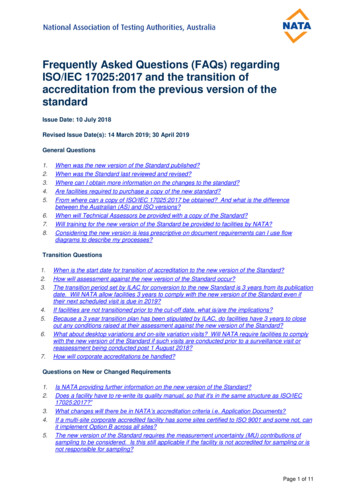

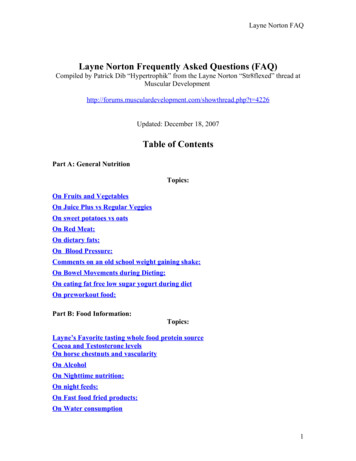
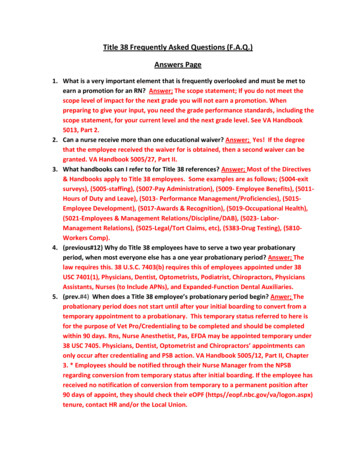
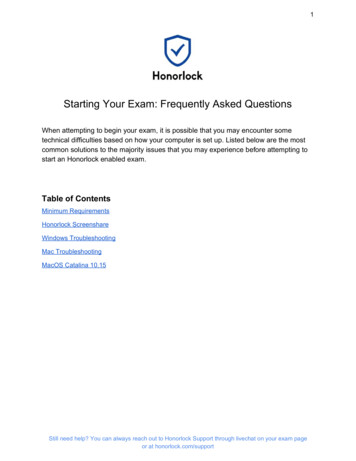
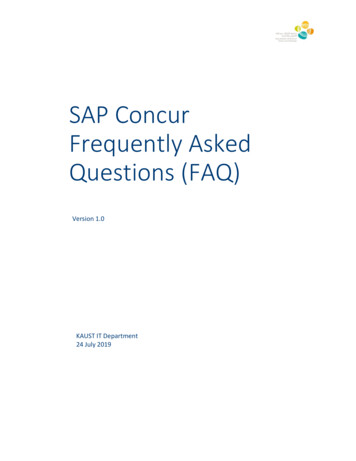
![Informatica Interview Questions and Answers [Scenario-Based]](/img/2/informatica-interview-questions-and-answers-scenario-based-1.jpg)
